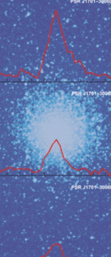Lesson Five : Millisecond Pulsars
Optical image of a millisecond pulsar with data from the pulses

Second Digital Sky Survey
Millisecond pulsars are a specific type of pulsar. They rotate hundreds of times per second at speeds close to one tenth of the speed of light at their equator. Astronomers think that these pulsars are relatively old and attain their high rotational speeds by pulling mass off of a companion star in a binary orbit.
Second Digital Sky Survey
When new mass is added to the system, conservation of angular (rotational) momentum causes the system to speed up. Angular momentum is conserved, which means that, in a spinning system, when an object stays the same size but becomes more massive, it speeds up, and when an object of constant size becomes less massive, it slows down. By accreting mass, the millisecond pulsar can reach extremely high speeds.
Atomic clock

NRAO / AUI
Neutron stars emit a lot of energy through their beams of radiation. As the neutron star loses energy, it slows down very gradually. In spite of this slowing, pulsars, especially millisecond pulsars, are incredibly accurate timekeepers. Their signals are received here on earth like the beat of a cosmic clock. If this signal is corrected for the slowing down effect with a computer, millisecond pulsars keep time as accurately as the best atomic clocks in the world.
NRAO / AUI